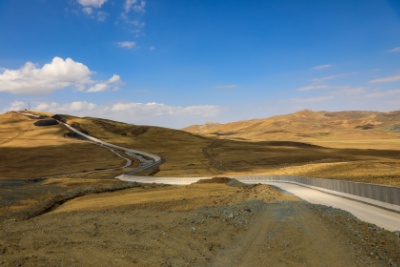
BACKGROUND: The Turkish-Iranian border measures 520 kilometers. On the Iranian side, the border is located in the West Azerbaijan province while on the Turkish side the provinces of Ağrı, Iğdır, Van and Hakkari border Iran. The wall, which is constructed with five layers of special concrete, consists of concrete blocks that each measure 2.8 meters, are 3 meters in height, and weigh 7 tons. With the barbed wire installed on it, the wall reaches a full height of four meters. It is equipped with observation towers, security cameras, lightening and surveillance systems.
The border wall was initiated in 2015 with the explicit aim of stemming what the Turkish authorities described as an ever-increasing flow of irregular mass migration. Starting in 2017, Turkey began the construction of a barrier along the Turkey-Iran border aimed at preventing illegal crossings, smuggling and Kurdish militants. More than one thousand Kurdistan Workers’ Party (PKK) militants are present in camps on the Iranian side of the border and the Turkish authorities anticipate that the construction of the border wall will prevent the movement from Iran of the PKK militants. In June 2018 Ankara announced that 764 kilometers of the Turkish wall had been completed and that the wall when completed will run along the entire 911-kilometre-long border with Syria as well.
Work on the construction of the border wall along the Turkish-Iranian border intensified in the summer of 2021 after the Taliban took power in Afghanistan. Turkish President Recep Tayyip Erdogan claimed that 300,000 Afghans had already arrived in Turkey and stated that Turkey is determined not to let any more Afghan refugees in. In December 2023, a major 170-kilometre portion of the wall was completed. The Turkish authorities announced that the “construction of the entire security wall and observation towers in the eastern province of Van, as well as the excavation of trenches, is ongoing to ensure the security of the entire 295-km border with Iran and to prevent illegal activities”.
However, the security threats on the Turkey-Iran border are not one-way as both countries face similar threats. Illegal immigration (mostly from Afghanistan), drug trafficking, arms smuggling and armed militants, are of concern for both Turkey and Iran. Iran, like Turkey, has experienced a new wave of legal and illegal immigration in recent years while the Islamic republic faces its own Kurdish challenge. The provinces on both sides of the Turkish-Iranian border are mainly Kurdish-populated, and while the PKK is a longstanding threat to Turkey, Iran is increasingly worried about the activities of the Komala Party of Iranian Kurdistan (Komalah) and of the Kurdistan Free Life Party (PJAK).
IMPLICATIONS: At the start of the construction of the border wall in 2017, Ankara emphasized that its construction was not aimed at Iran but rather was intended to improve regional security. In a similar vein, former Iranian Foreign Minister Bahram Ghasemi said that “we welcome any initiative aimed at making the border between the two countries safer. Border security is an important issue for both countries.”
Yet common security interests notwithstanding, the environmental impact of the Turkish wall is of growing concern for Iran. In May 2019, a joint environmental committee was set up between Iran and Turkey. Iran is also concerned about Turkey’s dam construction on the Aras River. In a letter to the Minister of Energy dated April 28, 2022, Mohammad Jafar Montazeri, the Iran’s then-Prosecutor General, issued an order to pursue the rights acquired by Iran from the Aras border river. He stated that “building several dams over the Aras border river and constructing walls on the zero point of the border by Turkey has led to a spread of sand and dust storms into western and southern parts of Iran”.
Iranian authorities are worried that Iran’s water resources and environment will be adversely affected by the construction of the wall, particularly in the province of West Azerbaijan. Iranian Deputy Interior Minister Majid Mir Ahmadi has criticized Turkey for creating “serious” environmental problems by constructing the wall, saying that “We have had and will have no problems in this regard as long as our [country’s] geographical and territorial limits are observed but [the border wall] has caused serious environmental problems for us and affected our rivers and environment”.
Masoud Bagherzadeh Karimi, former director of Wetland Ecosystems at the Iranian Environmental Protection Organization and responsible for monitoring the wall’s environmental effects, states that four ecological areas are affected by the border wall: The Boralan Wetland and Qarasu (Karasu) river which is shared between the two countries, the Yarim Qiya wetland and the Sarisu river flow into this lagoon shared between the two countries, the Agh Gul Wetland, and finally the Ararat National Park within Turkey’s borders.
The effects of the border wall on the water resources of the Sarisu and Qarasu rivers are among the most serious concerns. According to the treaty between Iran and Turkey from 1955, Turkey has an obligation to safely provide at least 1.8 m2/ second to Iran on the Sarisu River, including in the dry season, and both sides have the right to use water from the Karasu River so long as they do not violate the border. However, since the stone foundations and weight of the border wall block soil pores and openings, water exchange between the two sides is disrupted. These conditions will prevent Iran’s full exploitation of the Sarisu and Qarasu rivers, weakening agriculture in parts of West Azerbaijan province, particularly in the city of Mako. In addition, there are concerns about the water source of Soraya Spring (Cheshmeh Soraya), which is situated in the extreme northwest of Iran on the Iran-Turkey border. Soraya Spring is one of the biggest water sources in the province, supplying four thousand hectares with water in the region, as well as the water of Boralan International Wetland and the drinking water of 25 villages in the region. Hoshang Ziyai, a professor of wildlife, believes that in addition to the Boralan region, other areas and numerous wetlands will be severely damaged by the construction of the wall.
Moreover, Iran is concerned about the risk of flooding as a result of the closing of soil pores and openings, which causes water to accumulate behind the wall. Yaser Rehbardin, former CEO of the West Azerbaijan Regional Water Company warns that all the water outlets behind the border wall into Iran are blocked in the Boralan region, and that these blockages risk causing water to accumulate behind the border wall and cause severe flooding. Another serious concern is the threat to wildlife and its seasonal migration routes. According to Sayad Sheikhi, Ph.D. in Biodiversity at the University of Tehran, more than 80 percent of the communication path between the eastern and western parts of the biological diversity area is blocked by the wall.
CONCLUSIONS: Shiite Iran and Sunni Turkey have been at peace for nearly 400 years, with their common border being unchanged since the signing of the Treaty of Zuhab in 1639. Ultimately, the construction of the border wall is a sign of the end of four centuries of relative stability, with Turkey now facing the return of an older historic pattern of destabilizing migrations from Iran, Central Asia, Afghanistan and Pakistan toward the Middle East and Anatolia.
In coming decades, climate change – and the political, economic and security crises that are exacerbated by it – could trigger waves of mass migrations to the border of Iran and Turkey. Since the two countries have a common interest in mitigating these threats and challenges, Turkey and Iran will arguably be prompted to increase their security and intelligence cooperation. Notwithstanding that Turkey and Iran remain locked in a regional rivalry in the Middle East and in the South Caucasus, the completion of the border wall is still in the interest of both Ankara and Tehran.
Nonetheless, Iran is worried about the negative environmental, animal life and water resources consequences of the construction of the Turkish border wall. For Iran, the protection of the water resources of the Sarısu and Qarasu rivers is a particularly pressing concern. While shared common security concerns may eventually pave the way for closer cooperation between the two neighbors, the border wall potentially also introduces a new element of discord over environmental issues.
Vali Kaleji is based in Tehran, Iran, and holds a Ph.D. in Regional Studies, Central Asia and Caucasian Studies. He has published numerous analytical articles on Eurasian issues for the Eurasia Daily Monitor, the Central Asia-Caucasus Analyst, The Middle East Institute and the Valdai Club. He can be reached at This email address is being protected from spambots. You need JavaScript enabled to view it. .



